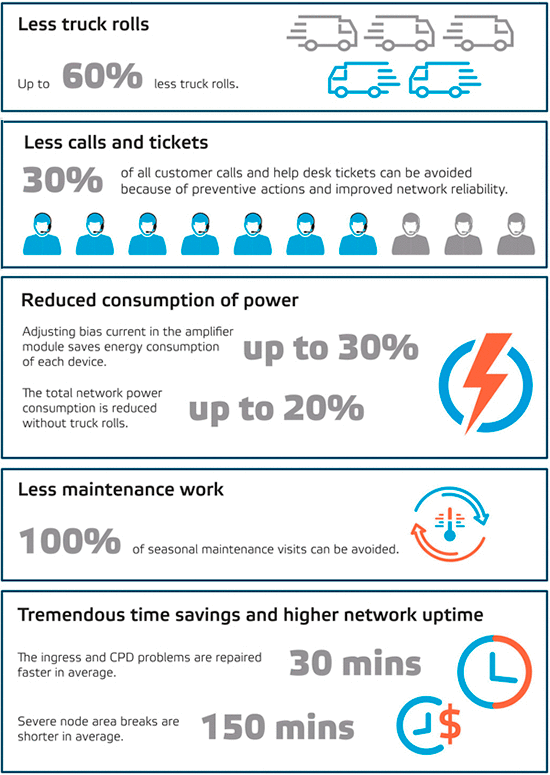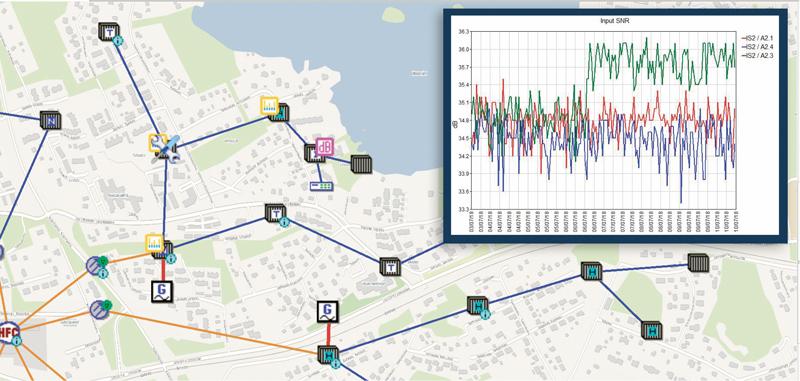Five ways to improve your business by utilizing the Intelligent Networks technology
Hanno Narjus, CEO of Teleste Intercept, Global Head of Network Products for Teleste | Published on Broadband Library
Added intelligence is the term of the day in many industries, and the cable industry is no different. Intelligent optical nodes and amplifiers and dedicated management software can bring you significant benefits by reducing operational costs and increasing service uptime. You can improve customer satisfaction while spending less time in network maintenance — just by utilizing devices in which traditional plug-in modules are replaced with electrical controls and reinforced by intelligent software that make the devices self-adjustable, auto-configurable and remotely controllable.
In addition to being state-of-the-art HFC and Remote PHY devices, intelligent network devices act as 24/7 probes in the cable television network. They constantly measure the quality of the signal that goes through them, produces information about their own status and even self-adjusts accordingly. Due to bidirectional communication between the devices and the management software, enabled by a transponder unit, you can get a precise view on the network status and perform several maintenance tasks without visiting the sites. Below, we introduce five ways that you can turn these functionalities into considerable business benefits.
1. Up to 60% less truck rolls
One key issue in network management and maintenance is that network problems can be difficult to locate. To fix an issue, operators need to go through complex network diagrams showing where each element is installed — or, in the worst case, technicians need to chase the root of the problem in the field, driving from one device to another. This makes fixing service issues slow, leads to higher repair costs and takes customers onto a path potentially leading to churn [1].
Although information on the status of network elements is a basic feature in many network management systems, they often fail to deliver accurate information on where these elements are physically located. Intelligent network devices, on the other hand, can be used to find out where the disturbances enter the network and what their impact areas are. The management software can attach detailed spatial information to each device and, when information from an affected device arrives, show its exact location on a map.
Experiences from the field show [2] that up to 60% of truck rolls can be avoided by knowing precisely where to go to fix a problem. The maintenance process can be further streamlined by taking advantage of the remote management and automatic features provided by the Intelligent Networks — which brings us to our next benefit: utilizing the technology to improve customer satisfaction.
2. 30% less tickets and calls to help desk
Network reliability is the single-most influential factor causing customer dissatisfaction in the cable television industry. Slow connectivity and service outages quickly cause escalation of the number of help desk calls, and the dissatisfaction likely leads to churn if fostered by negative interactions with the help desk [*]. For this reason, it becomes of utmost importance that the helpdesk knows what is ongoing in the network and is able to help customers smoothly and proactively.
Intelligent Networks management software can provide the needed information from the device level up and, as mentioned above, help fixing issues quickly and effectively. In addition, intelligent network devices feature an automated ingress-switching functionality that allows segregating the failing network segments until fixed, thus limiting the number of homes contaminated by the ingress. Reinforcing the positive customer experience, even 30% of all customer calls and tickets can be avoided because of preventive actions and improved network reliability. [2]
3. Up to 20% reduction in power consumption
Most of the power consumption of the active CATV network equipment occurs in the amplifier module, referring to a typical hybrid component in the output stage of an optical node or amplifier station. Intelligent nodes and amplifiers introduce several innovations for controlling power consumption in the amplifier module, including remotely adjustable performance levels as well as autonomous and load-based performance adjustment. These are based on the simple idea to save energy by adjusting bias current in the amplifier module according to the actual capacity in use.
Although nodes and amplifiers are designed and operated to fulfill their specifications at the full 1.2 GHz load, the actual capacity used in the network is seldom that heavy. When the maximum capacity is not in use, the amplifier module can be operated at lower bias current, leading to less power consumption. This can save up to 30% of the power consumed by the amplifier module, which, in turn, can reduce the total network power consumption by up to 20%, all without truck rolls. [3]
 4. 100% less seasonal maintenance visits
4. 100% less seasonal maintenance visits
With constantly increasing capacity demands, broadband network operators need to invest heavily in both new network hardware and the maintenance and renewal of their networks. More devices mean more frequent maintenance operations, such as seasonal visits to the site, due to changing temperatures. To avoid regular network visits, the intelligent network devices are able to reconfigure themselves and keep all adjustments precise. Therefore, e.g., temperature changes do not impact the network performance, and consumers can enjoy robust broadband speeds.
5. Higher network uptime and considerable savings in time and money
The overall impact of Intelligent Networks on network maintenance is significant. Experiences from our customers show that, on average, the technology enables a 30-minute-faster repair time for the ingress and CPD problems while making severe node area breaks 150 minutes shorter. [2] Scaled to the entire network level, the increase in service uptime is remarkable, as are the monetary benefits.
According to our research in Europe, moving to intelligent network architecture in a medium-sized network of 120,000 users can amount to operational savings of close to 10 million euros ($11.5 Million) over 15 years, hence reducing the accumulated total cost by more than 50%. For a large network of 1.2 million users, this means savings of almost 100 million euros ($115 Million) over 15 years. [2] In areas with lower subscriber density and more prevalent truck rolls, these numbers could be even higher.
Teleste Intercept
offers a wide range of intelligent optical nodes and amplifiers, and software for Intelligent Network management. We also have long-term experience in network architectures and their design, planning, installation and maintenance.
If you wish to discuss more about our solutions and their benefits, please contact sales@telesteintercept.com
About the author
Hanno Narjus, CEO of Teleste Intercept, Global Head of Network Products for Teleste
Hanno Narjus has more than 30 years’ experience in the ICT sector, including mobile communications, fixed broadband as well as cable networks. Currently, Mr. Narjus is CEO of Teleste Intercept and in charge of the global Network Products business for the Teleste Corporation. He is also a member of Teleste’s management team. Before this, Mr. Narjus held several managerial positions in the telecommunications industry. In addition, he has earned a master’s degree in economics from the University of Tampere in Finland.
References:
- Purmonen, Arttu (2017). Customer Pre-churn Analysis of the Cable Television Industry (whitepaper of the Teleste Corporation.
- Purmonen, Arttu (2017). Intelligent Tools to Increase Uptime in the HFC Plant (whitepaper of the Teleste Corporation.
- Teleste Corporation (2018). Adaptive Power Challenge, Make sense, Solution description: https://www.adaptivepowerchallenge.com/en/solutions/make-sense/ (accessed July 2018).






